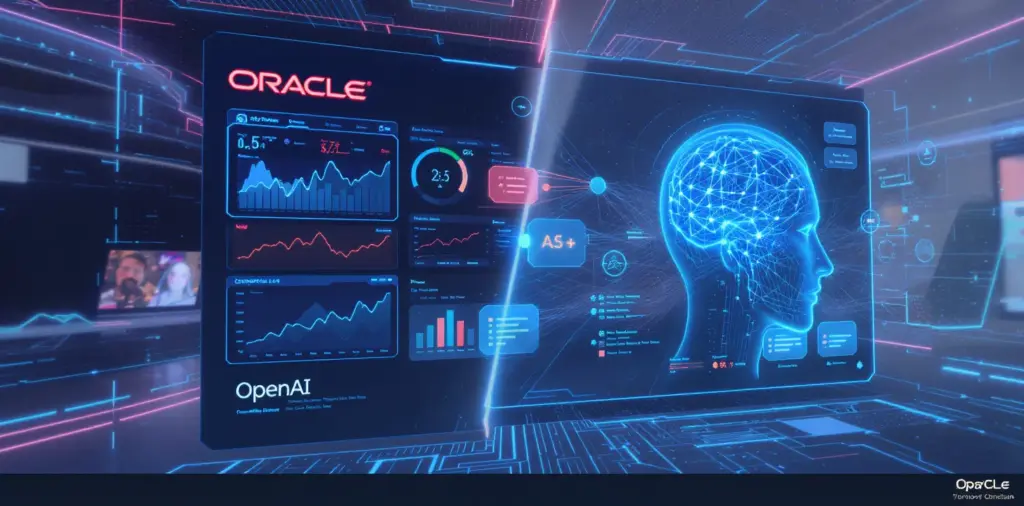The Second Order: Oracle–OpenAI Meets Nvidia’s $100B Bet and Rewires the AI Capital Stack

Scene-Setter: Two Shockwaves in One Fortnight
Within days of Oracle’s $300B OpenAI compute headlines, Nvidia unveiled plans to invest up to $100B in OpenAI and to deliver gigawatt-scale AI systems starting in 2026. Equity markets ripped to fresh highs, with AI bellwethers dragging indices along for the ride. The message: AI is not cyclical gadgetry—it’s long-cycle infrastructure.
The Architecture of an AI Super-Cycle
Compute demand certainty: When a model-rich buyer like OpenAI commits to multiyear, multi-GW capacity—and the upstream GPU supplier simultaneously commits equity and systems—downstream cash-flow visibility for datacenter builders and cloud operators improves dramatically. That’s why Oracle’s stock repriced and why risk appetite broadened.
Cross-cloud normalization: The 2024 disclosure that OpenAI could extend Azure workloads into Oracle previewed this exact future: AI demand will not fit inside one cloud; it spills over to wherever power + land + interconnect exist. The September news flow is that thesis going “live.”
Power is policy: Multi-GW data centers are effectively energy projects with AI front-ends. Expect state-by-state competition for sites, accelerated grid upgrades, and an industrial-policy vibe around siting and incentives. Commodity markets (copper, transformers), EPC firms, and utilities become stealth AI plays.
What It Means for ORCL’s Stock Path From Here
Near term (weeks–months): After a 36–43% gap, digestion is normal. Pullbacks on headlines (permitting delays, component shortages) would not invalidate the core thesis: Oracle’s forward revenue mix is shifting toward annuity-like AI infrastructure.
Medium term (12–24 months): The stock’s factor exposures become more rate-insensitive than typical software, because revenue growth is tethered to physical capacity delivery, not just seat-based SaaS. Investors will monitor GW delivered, backlog conversion, and gross-margin cadence as power costs and supply contracts flow through. Reuters captured that the market is now valuing Oracle alongside trillion-dollar peers, contingent on execution.
Key risk radar:
• Timing risk: The deal reportedly starts in 2027—there’s time for macro or regulatory friction.
• Concentration risk: Heavy reliance on a few AI anchors, unless Oracle continues to diversify (reports also flag large prospective contracts elsewhere). Data Center Dynamics
• Narrative risk: Critical voices argue the numbers are heroic; any sign of delayed ramps could compress multiples.
Global Markets: How the Ripples Propagate
Equities: The September moves illustrated how AI capex can carry the tape: Oracle’s surge alone helped propel the S&P 500 and Nasdaq to records. If Oracle and peers keep printing capacity-anchored guidance, tech’s premium can persist even with soft-landing growth.
Credit: Multi-year buildouts favor IG issuance from utilities, hyperscalers, and equipment vendors; spreads may stay resilient as investors “buy the rails” of AI.
Rates: Enduring AI capex is mildly term-premium supportive—a structural investment wave that keeps nominal growth expectations from collapsing.
FX/EM: Regions that can offer fast interconnect + reliable power may attract AI FDI; commodity exporters linked to grid buildouts benefit at the margin.
The AI Market Structure Angle
From GPUs to grids: Nvidia’s $100B alignment with OpenAI confirms that supply-chain sovereignty (chips + systems + software) is strategic. Oracle’s role is to tame the other half: sites, power, cooling, and fiber. Together, they formalize a two-sided market—model developers pre-commit demand; infra providers pre-commit capacity. The “price” is a long-dated capex boom.
Cross-cloud era: With Azure already the historical anchor for OpenAI, the ability to burst into OCI is now de-risked by design. This is less “multi-tenant cloud” and more multi-grid compute fabric, stitched across providers.
Investment Synthesis: A Cohesive Thesis for the AI-Infra Trade
For ORCL specifically:
- Core: Treat Oracle as a scarcity asset in the AI-infra stack, not just an enterprise-apps incumbent. The new information is duration and scale, which justifies a higher growth-and-visibility multiple—if the company converts reported bookings into energized megawatts and billable GPU-hours.
- Catalysts: Site announcements, GW energization milestones, interconnect wins, cross-cloud traffic telemetry, and incremental anchor tenants.
- Watchouts: Power pricing shocks, permitting delays, or a cyclical lull in model-training intensity that slows ramps; skeptics flag the sustainability of the $300B pace.
For the broader market:
- Semis & equipment: Visibility improves (Nvidia’s alignment is explicit), supporting valuation resilience through the next chip cycle.
- Utilities & grid tech: Quiet beneficiaries as AI becomes an energy story.
- Software apps: The bar rises; compute-heavy use-cases ride tailwinds, but unit economics will matter once supply tightness eases.
Why This Is Not Just Hype
The 2024 cross-cloud disclosure gave the blueprint; 2025 supplied scale and capital. Markets are responding to real capacity commitments—not marketing decks. That’s why Oracle’s stock printed a move you don’t often see in mega-caps, and why indices followed. AI is industrializing.
Closing Perspective
The Oracle–OpenAI alignment, amplified by Nvidia’s capital and systems, signals a new market phase: compute as critical infrastructure. For investors, the question isn’t whether AI matters; it’s whose bottleneck is scarce, who controls it, and who can deliver it on time. Right now, the market is betting Oracle is one of those gatekeepers—and pricing it accordingly.
Notes on Sources & Uncertainties: Several specifics of the OpenAI–Oracle contract (start date, exact volumes, and step-ups) are reported by third-party outlets and have not been fully detailed in primary disclosures; investors should treat them as directional until formally confirmed. For background on the Azure-to-OCI extension, see Oracle’s June 11, 2024 press release; for September’s price action and index impact, see Reuters and Business Insider; for infrastructure scale and timelines, see Data Center Frontier, PYMNTS, and contemporaneous coverage.
